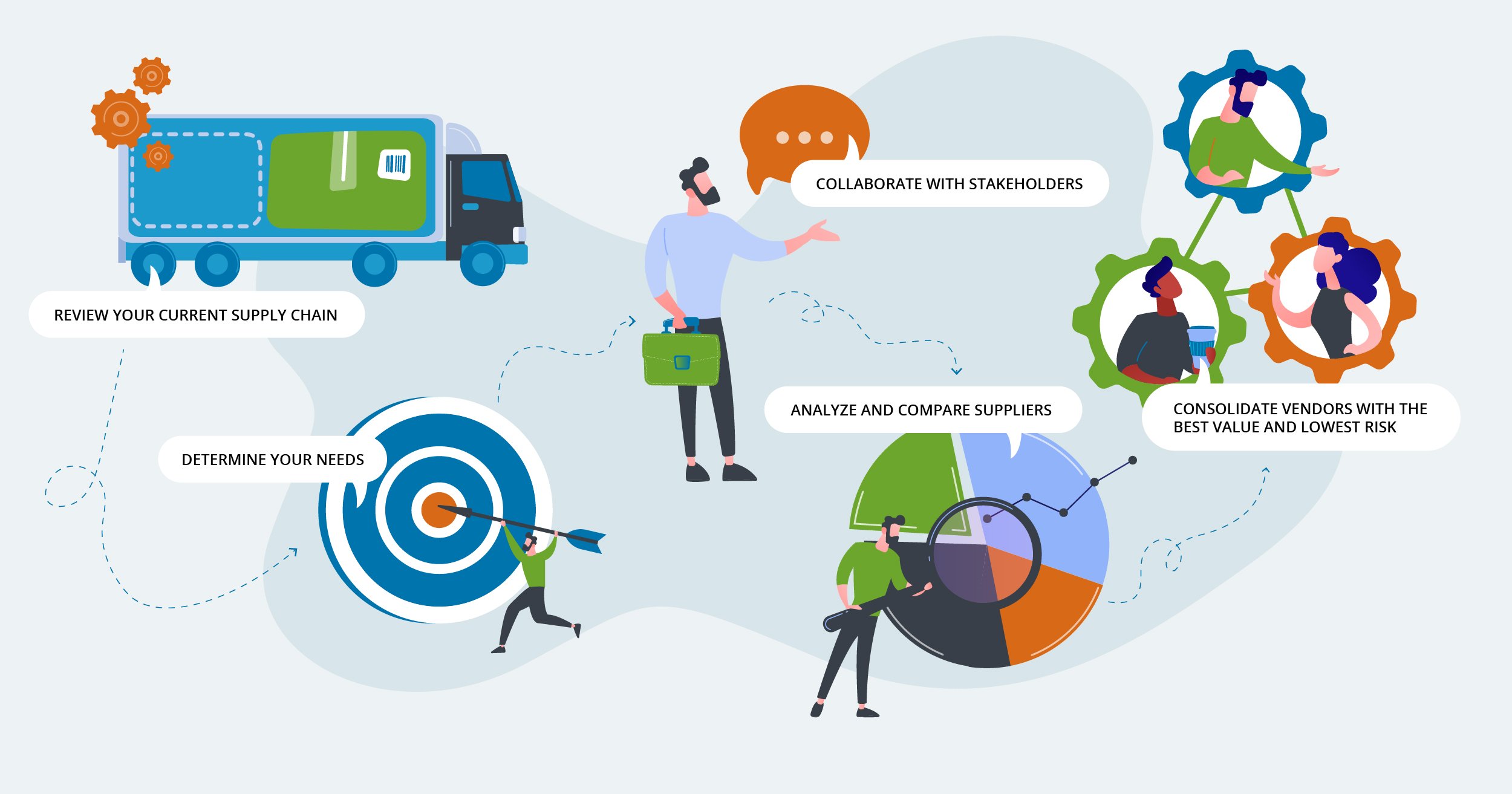Are you in the process of implementing Ariba? We understand that it can be a monumental task that...
Benefits of vendor consolidation in manufacturing
A healthy cash flow is the lifeblood of any organization, whether it’s a small business or a giant corporation. Managing cash flow is an ongoing battle for organizations of any size as they try to balance payables, credit, receivables, inventory and sales. Vendor consolidation can help.
This strategy involves working with fewer vendors and focusing on nurturing relationships with a select few. This approach is not just about cutting down the number of suppliers; it's about identifying those that are—or could be—core to your business.
Cash flow management and supplier consolidation
First, it’s important to note that when many organizations are looking to cut costs, they tend to focus on direct procurement — or the process of purchasing services, goods or raw materials used in core business operations. While direct spend accounts for the majority of a company’s operating expenses, it doesn’t account for the indirect costs required to support day-to-day activities.
These are the often-overlooked indirect operating expenses, such as computers, office supplies, tools and equipment, associated with daily business operations — which, according to McKinsey, have been growing by 7% each year since 2011.
Along with the rising costs of indirect procurement, the most significant challenge of managing this spend category is the vast network of different vendors used for everyday business purchases. With hundreds of them used across various departments, it can be exceedingly difficult to monitor your supply chain for risks, identify and capture cost savings opportunities, build relationships, and ultimately, reduce expenses to create a healthy cash flow.
Additionally, dealing with invoice after invoice for each vendor can quickly become time-consuming and tedious work that costs your company in employee time.
How does this help solve cash flow issues?
According to a study from The Hackett Group, supplier consolidation can reduce the costs of general equipment and supplies by around 9.18%. Beyond the upfront cost of purchasing essential products and services, the study also found that it costs up to $1,400 in internal costs to identify, onboard and process a transaction with each new supplier.
The benefits of vendor consolidation
Consolidation can unlock numerous benefits to help reduce costs and, therefore, improve your business cash flow, including:
- Standardizing to drive transparency: Organizations often have a difficult time tracking where their money goes — which, if left unchecked, represents a significant risk to cash flow. By reducing the amount of businesses you work with, you can create a simple, standardized procurement process using a list of preferred vendors. That way, everyone in your organization knows where to go when they need to place an order.
- Driving process efficiency: Breaking down these procurement silos can also increase overall process efficiency, generating savings in regard to labor. As the previously mentioned Hackett study finds, those in the top quartile of supplier consolidation can expect to see a significant reduction of internal costs associated with the procurement process.
- Increasing visibility into tail spend: If your cash outflow seems abnormally high, it could point to cost inefficiencies due to rogue spending — or uncategorized, unmanaged purchases. Oftentimes, these costs stem from the tail end of an organization’s budget in categories such as maintenance, repair and operations (MRO). Using a standardized procurement process across fewer vendors can help you dramatically improve expense visibility to track spend and critical KPIs, such as delivery timing and compliance.
- Strengthening relationships: With a small list of business partners that offer the best value, it’s easier to build and manage lasting connections. This reduction in supplier interactions can also save both time and procurement costs for your organization.
- Better payment terms: As you develop these contacts, you can use your long-standing history with suppliers to negotiate more favorable payment terms and competitive pricing. This can improve your profit margin and help you achieve a positive cash flow forecast.
- Risk mitigation: By working with a select few reliable suppliers, businesses can reduce the risk associated with supplier failure or supply chain disruption. An Economist Impact study found that these disruptions incur substantial financial costs (averaging 6-10% of annual revenues). With macroeconomic and geopolitical forces continuing to impact supply chains, risk mitigation has shot up the procurement agenda.
5 steps to consolidate your vendors
To help guide you through the process, here are five steps you can take to evaluate your providers and create a chosen list:
1. Review your current supply chain
Assess your supply chain and vendor network to understand your current status. As you review this, be sure to ask yourself questions like:
- Which vendors are you currently using and where are they located?
- Are you using multiple suppliers for the same products?
- If you only source a few items from a single business, is there another one you could use instead?
- Which suppliers have you had the best experiences with?
Answering these questions will help you in the next steps.
2. Determine your needs
Once you understand your current supply chain, it’s time to focus on what you need. Set goals for supplier consolidation and cost optimization, then identify the metrics you’ll track to measure performance. You’ll also want to start making the business case for consolidation and communicating the benefits with decision-makers.
3. Collaborate with stakeholders
As you develop your plan, you’ll want to create a team of stakeholders with varying priorities to gather feedback. They may have different vendor standards, so it’s important to discuss their needs and work together on an action plan.
4. Analyze and compare suppliers
Dig into the data and conduct a supplier analysis that categorizes and compares your providers. Work with stakeholders to develop agreed-upon criteria and metrics that you can use to evaluate their performance. Then, separate suppliers into groups based on high-, low- and under-performance. That way, it’s easy to see which vendors are valuable and which ones you might be able to leave behind.
5. Consolidate vendors with the best value
Based on stakeholder feedback and vendor analysis, determine which providers can help your business reach its goals and which ones you can do without. Unfortunately, there’s no magic formula for the right numbers, so the ultimate decision will be up to you — but remember that any vendor relationships you choose to keep should add consistent, sustainable value to your organization.
Challenges of consolidating suppliers
This process is not without its challenges. Reducing the number of suppliers can lead to over-reliance on the remaining ones, potentially increasing risk if a key vendor fails. It can also limit competition, which may result in less innovation and reduced incentive for suppliers to keep prices competitive. Additionally, the process of consolidating vendors can be complex and time-consuming, requiring careful planning and management to avoid disruptions to the supply chain.

Optimize indirect procurement with DSSI’s source-to-pay services
DSSI takes vendor consolidation to the next level with a wide range of robust services and innovative solutions. As a comprehensive source-to-pay provider, we help you standardize your procurement process for any and all indirect materials under one standard payment term.
Our eProcurement platform , Epic®, gives you access to our vast network of suppliers through a strategically sourced and managed catalog that consolidates everything into one invoice. Not only does this save you time and money, it also enables on-demand enterprise-level spend visibility and KPI reporting tools to streamline the entire procurement process.
In addition, clients can leverage DSSI’s strong supplier relationships and group sourcing aggregation to drive advantaged pricing. Our professional category management team continuously manages supplier performance to ensure timely deliveries and compliance with service-level agreements.
To discover how you can consolidate vendors and optimize cash flow with DSSI, contact us today.



